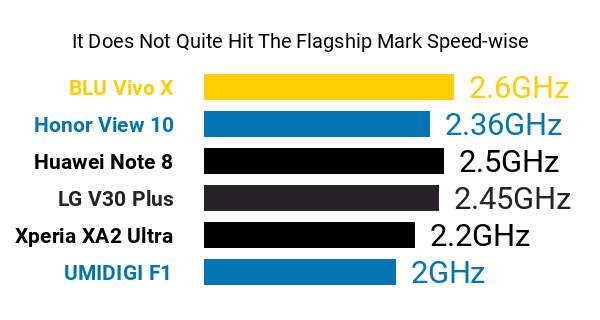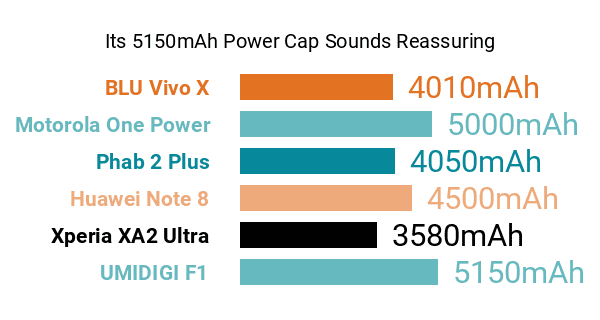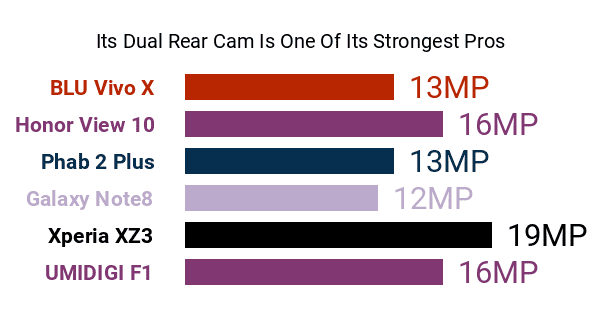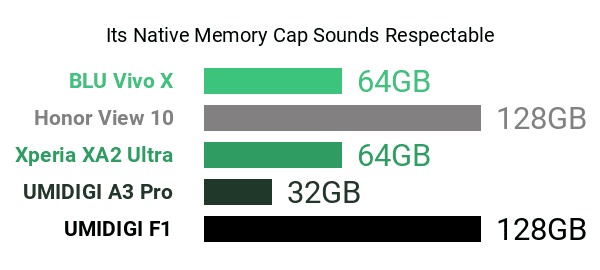- Analysis by KJ David
One of UMIDIGI's earliest 2019 releases (and also the first one under the brand's F-series), the UMIDIGI F1 targets power-hungry middle-class smartphone shoppers with its assortment of pros and cons. Sadly, it won't find itself alongside the best octa-core phones of its time, at least considering its Helio P60 engine's 2GHz top speed  -- some full-blown high-enders use processors clocked at roughly 2.5GHz. Having two distinct 2GHz quad-core clusters sounds noteworthy, though. Another slight flaw is its relatively modest 4GB RAM
-- some full-blown high-enders use processors clocked at roughly 2.5GHz. Having two distinct 2GHz quad-core clusters sounds noteworthy, though. Another slight flaw is its relatively modest 4GB RAM  , given the number of competing phablets that boast 6GB or even 8GB RAMs.
, given the number of competing phablets that boast 6GB or even 8GB RAMs.

On the flip side, its favorable specs are headlined by a large 5150mAh battery  that powers up through an 18W charging system, calling up this Phonerated list of the best big-battery smartphones available. Also, while its 6.3-inch screen sticks to a 1080p FHD+ resolution only
that powers up through an 18W charging system, calling up this Phonerated list of the best big-battery smartphones available. Also, while its 6.3-inch screen sticks to a 1080p FHD+ resolution only  , instead of shooting for a premium-class QHD/QHD+ (1440p) sharpness, its 19.5:9 aspect ratio
, instead of shooting for a premium-class QHD/QHD+ (1440p) sharpness, its 19.5:9 aspect ratio  and waterdrop notch design nonetheless make it a pro in our book.
and waterdrop notch design nonetheless make it a pro in our book.

Imaging-wise, the F1 possibly holds its own versus many other middle-class contenders as of this on-paper review, touting a 16- plus 8-megapixel dual rear camera  rigged with a 6-element lens and a dual-LED flash. Sitting on its small screen notch is a respectable 16-megapixel f/2.0-aperture selfie camera
rigged with a 6-element lens and a dual-LED flash. Sitting on its small screen notch is a respectable 16-megapixel f/2.0-aperture selfie camera  whose resolution was within the high-end category when this model was released.
whose resolution was within the high-end category when this model was released.

The F1's pros and cons also include a 128GB storage memory expandable by up to 256GB  , NFC (Near Field Communication) support for cashless mobile payments, and two nano SIM card trays. It runs on Android 9.0 Pie out of the box and is offered in Black, Gold, and Red.
, NFC (Near Field Communication) support for cashless mobile payments, and two nano SIM card trays. It runs on Android 9.0 Pie out of the box and is offered in Black, Gold, and Red.

Summing up, although it has some slight cons on the hardware front, the UMIDIGI F1 nevertheless caters to those eying a high-stamina, middle-class phablet.
On-paper Review score: 
It's all well and good that the UMIDIGI F1 can record high-resolution 1920 x 1080 movies, but we were disappointed not to find any evidence of the F1 featuring an HDMI port (which is convenient to watch HD videos on your shiny HDTV.)
- We recommend: The latest HDMI phone models
It's disappointing that we could not find its weight information.
- Recommended alternative: Photo gallery of the latest slim phones
Its processor speed of Quad 2GHz (+ Quad 2GHz) running on 8 cores is part of the fastest in recent phones.
- Also read: List of the latest octa-core smartphones
NFC is used by electronic payments and other applications.
- See also: The latest NFC-enabled phones
It carries the Miracast technology, a system that lets you share your display with a TV
We're dealing with a hefty display here, making it a phablet: 6.3 inches and a resolution of 2340 x 1080 pixels means about 15.1 square inches and an image quality of at least 409 dots per inch (DPI)!
The F1 is one of the rare phones to feature a 16-megapixel (combined with an 8-megapixel sub-cam) camera. It also sports these features: Panorama.
If UMIDIGI's claim is accurate, the F1 and its (5150mAh)
The 16-megapixel selfie cam offers an above-average resolution.





You Should Also Check These Out:
 Full Menu
Full Menu